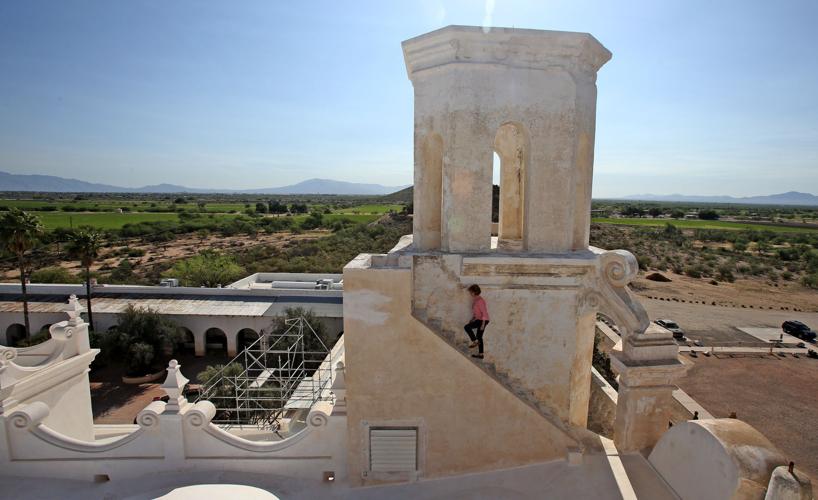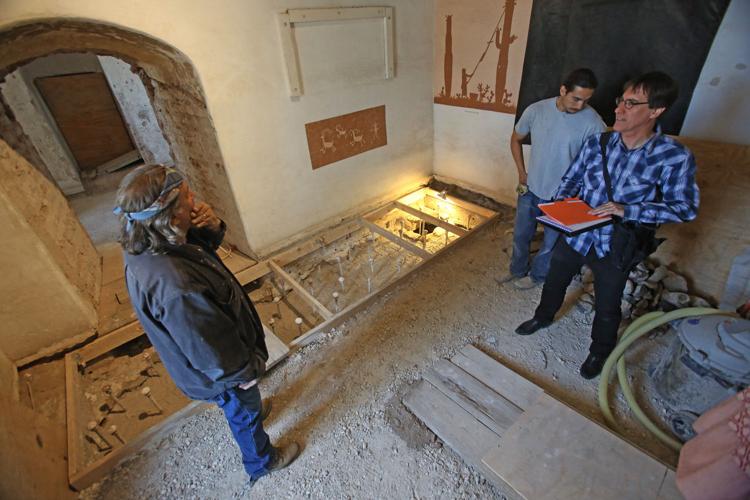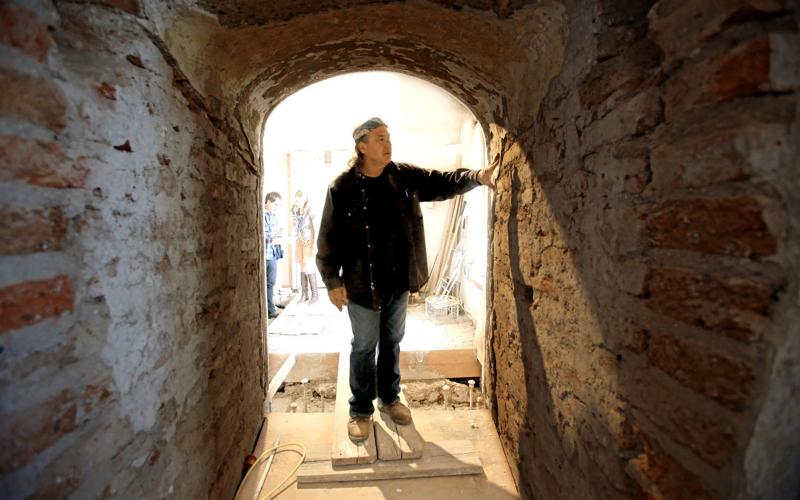Standing on the east tower of Mission San Xavier del Bac, Bob Vint’s fingers graze the cracking plaster.
If Vint, the architect for the mission’s restoration, has anything to say about it, this tower will finally get its due after being an unintentional afterthought for so many years.
“We are gearing up to tackle the last, structural refinishing of the east tower,” Vint says. This project will strip the tower of its cement exterior, repair the original low-fire clay bricks and refinish it with traditional materials.
Vint recommended removing the problematic concrete layer from the mission to the nonprofit Patronato San Xavier in 1989. When the restoration of the east tower is finally complete, the cement added in the 1950s will no longer suffocate any part of the mission.
“The east tower will complete the liberation of San Xavier of cement, because it has been encased for more than half of a century,” Vint says. They have been removing the stuff since the 1990s.
Since 1978, nonprofit Patronato San Xavier has overseen the preservation of and fundraising for the mission, also called the White Dove of the Desert.
Through a $3 million capital campaign for east tower restoration, the nonprofit intends to complete its removal of the cement layer smothering the mission. The campaign launched quietly in 2013 and has so far raised $800,000. Now, the public phase will begin.
Funding for work on the mission’s east tower is also included in the bond proposal approved by the Pima County Board of Supervisors on Tuesday. Falling under Natural Area Conservation and Historic Preservation, mission restoration would receive $2.5 million, a sum Patronato San Xavier must match over a 10-year period, says Barbara Peck, a board member of the nonprofit and the co-chair of the $3 million capital campaign. Any excess money would go toward additional mission restoration, if voters select that package in the fall.
They are fundraising now so restoration of the east tower can proceed even if the mission does not receive any bond money.
“We started doing all of that with the roof and the walls and the sanctuary, and we just somehow continued to miss the east tower,” says Chuck Albanese, the president of Patronato San Xavier and former dean of the University of Arizona’s College of Architecture, Planning and Landscape Architecture. “Something else was always a priority, but right now, having recognized the condition of it, the deterioration is accelerating, and it may be more urgent than we actually realize.”
That’s because no one really knows about the condition of the bricks beneath the cement, says contractor Daniel Morales. His family has worked on mission restoration for generations.
The original builders never finished the east bell tower. It has no dome, and for about 120 years many of its bricks lacked a protective plaster.
“The original intention was for this to have a dome and lantern, but they never finished and left the exposed brick,” Vint says. “There are myths about why it is not finished.”
But it’s actually quite simple, he adds. The builders ran out of money.
Around 2009, with the completion of the restoration of the west tower, history repeated itself.
“When we completed the west tower, we had anticipated to get started right away” on the east tower, Peck says. “We had state Heritage Fund money, and that was before the economy started to decline, and the state swept that back into the general fund.”
The west tower project cost about $2.5 million and took about six years to restore, Vint says. He guesses that the east tower will be in worse condition structurally, but it does not have the dome or architectural flourishes that made restoration of the other tower so painstaking.
Morales and his crew have already begun reinforcing the tower’s foundation, but they do not want to build scaffolding until they know they have funding to finish. Morales estimates that the restoration will take five years. With the exception of a few tools, everything is done by hand. It’s slow work.
“In addition to the fact that the work takes a while, is that Danny can’t hire 10 guys when he doesn’t have the budget,” Vint says. “He has a budget for four guys, so that also affects the pace of the work.”
When builders in the 1950s applied the layer of cement plaster to the mission, they smothered the bricks, creating an environment for moisture and mold to cause structural damage. The cement must be removed and repairs made with a mortar made of lime, sand and a prickly pear glue — all compatible with the original construction. A plaster made of the same materials finishes the project, allowing the bricks to “breathe.”
The cement was meant to protect the brick, Vint says. “As it turned out, the cement was incompatible with the original construction and caused unforeseen deterioration, which now we’re getting to see as chunks of the cement fall off, and we’re getting to see the brick is all eaten away by trapped moisture.”
Loose and falling chunks of concrete on the east tower have forced Morales’ crew to do some preventative maintenance, removing loose cement and applying a lime-mortar wash.
“Lime is a lost art, pretty much,” Morales says. “It’s a material that does not set like cement. Concrete starts to hydrate the minute you start adding water, but lime will not. If you don’t do it properly, it will fail on you.”
And they are determined to do this right.
“When you’ve got old stuff, you’ve got to take care of it,” Vint says.
Other future projects for the mission include a restoration of the front facade and work on the mortuary chapel and walls surrounding the graveyard. With the building “open to the climate,” interior artwork will always be in need of preservation, Peck says.
“You’d always like to think that a beautiful piece of art is never finished, and that is the case in the design and construction of San Xavier,” Albanese says. An old building built with basic resources “will always need restoration and conservation.”
But for now, the east tower, with its missing dome and weathered bricks, will finally get the limelight.







